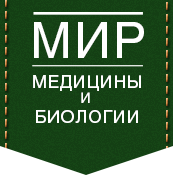| Список цитируемой литературы |
- Berezhnaia NM. Toll-like retceptory i onkogenez. Onkologiia. 2013; 2 (15):76–87.
- Dola OL, Lakatosh VP, Antoniuk MI, Lakatosh PV. Pokazateli sistemnogo immuniteta u zhenshchin s persistiruiushchei formoi latentnoi papillomavirusnoi infektcii sheiki matki posle vaktcinatcii protiv VPCh. Reproduktivnoe zdorove. Vostochnaia Evropa 2017; 7(4):581-586.
- Krutikova EI, Hromova AM. Kilkisne papilomavirusne navantazhennia slyzovoi obolonky shyiky matky pry tservikalnii intaraepitelialnii neoplazii yak kryterii efektyvnosti kompleksnoi peredoperatsiinoi terapii. Zbirnyk naukovykh prats asotsiatsii akusher-hinekolohiv Ukrainy; 2017 veresen 21-22; Odesa. Rivne:PP Estero; c.151-155.
- Rogovskaia SI, Lipova EV, pedaktori Sheika matki vlagalishche, vulva. Fiziologiia, patologiia, kolposkopiia, esteticheskaia korrektciia: rukovodstvo dlia praktikuiushchikh vrachei Moskva: Izdatelstvo zhurnala Status Praesens; 2014. 832c.
- Daud II, Scott ME, Ma Y, Shiboski S, Farhat S, Moscicki AB. Association between toll-like receptor expression and human papillomavirus type 16 persistence. Int J Cancer. 2011 Feb 15; 128(4):879-886.
- Dong J, Cheng M, Sun H. Function of inducible nitric oxide synthase in the regulation of cervical cancer cell proliferation and the expression of vascular endothelial growth factor. Mol Med Rep. 2014; 9(2): 583–589.
- Ferlay J, Shin H, Bray F, Forman D, Mathers C, Parkin D. GLOBOCAN 2008: Cancer Incidence and Mortality Worldwide: IARC Cancer Base N 10 [Internet]. 2010 [last accessed 2013March] Lyon, France: Internetional Agency for Research on Cancer;. Available at: http://globocal.iarc.fr.
- Flatley JE, Sarqent A, Kitchener HC, Russell JM, Powers HJ. Tumour suppressor gene methylation and cervical cell folate concentration are determinants of high‑risk human papillomavirus persistence: A nested case control study. BMC Cancer.2014; 14: 803.
- Fowler J, Jack B. Cancer, Cervical. Boston University School of Medicine: JPS Health Network StatPearls Publishing LLC. 2017; Available from: (http://creativecommons.org/licenses/by/4.0/).
- Guo LW, Zhang SK, Liu SZ. Human papillomavirus type-18 prevalence in oesophageal cancer in the Chinese population: a meta-analysis, Epidemiology and Infection. 2016; 144(3):469–477.
- Huang MZ. Central South University, Changsha: An analysis on the combination expression of HPV L1 capsid protein and p16INK4a in cervical lesions. Diagn Pathol. 2010; 38(8):573-8.
- Heunis N, Horton A, Richter KL, Dreyer G, Louw M. HPV L1 capsid protein detection in high-risk human papillomavirus-positive cervical smears. South Afr J Gynaecol Onco. 2014; 6 (1): 22-26.
- Jahani-Asl A, Bonni A. iNOS: a potential therapeutic target for malignant glioma. Curr Mol Med. 2013; 13(8):1241–1249.
- Kumar A, Yu F, SX. Toll-like receptors and corneal innate immunity. Curr Mol Med. 2006; 6(3):327–337.
- Kim WY, Lee JW, Choi JJ. Increased expression of Toll-like receptor 5 during progression of cervical neoplasia. Int J Gynaecol Cancer. 2008; 18:300–305.
- Kobayashi LC, Limburg H, Miao Q, Woolcott C, Bedard LL, Massey TE Aronson KJ. Folate intake, alcohol consumption and the methyl enetetrahydrofolate reductase (MTHFR) C677T gene polymorphism: influence on prostate cancer risk and interactions. Front Oncol. 2012; 2: 100.
- Konopnicki D., Manigart Y, Gille C. High-risk human papillomavirus genotypes distribution in a cohort of HIVpositive women living in Europe: epidemiological implication for vaccination against human papillomavirus. AIDS. 2016; 30(3): 425–433.
- Li J, Rao H, Jin C, Liu J. Involvement of the Toll-Like Receptor/Nitric Oxide Signaling Pathway in the Pathogenesis of Cervical Cancer Caused by High-Risk Human Papillomavirus Infection. Biomed Research International. 2017, [Published 24 May 2017] Article ID 7830262, P.1-8. Available from: https://doi.org/10.1155/2017/7830262.
- Li, Q., Ding, L., Jing, N., Liu, C., Yang, Z., Chen, F., & Wang, J. Folate deficiency and aberrant DNA methylation and expression of FHIT gene were associated with cervical pathogenesis. Oncology Letters, 2018; 15(2), 1963-1972,
- Olsson SE. Induction of immune memory follwing administration of a prophylactic quadrivalent human papillomavirus (HPV) types 6/11/16/18 L1virus-like particle (VLP) vaccine. Vaccine. 2007; 25:4931-4935.
- Picard A, Badoual C, Hourseau M. Human papilloma virus prevalence in HIV patients with head and neck squamous cell carcinoma. AIDS. 2016; 30(8):1257–1266.
- Rogovskaya SI. Vaccines against human papillomavirus: new opportunities for preventing cervical cancer. Gynecology. 2010; vol. 9, (1):15-20.
- Reuschenbach M, Seiz M, Doeberitz CK, Vinokurova S, Duwe A, Ridder R, et al. Evaluation of cervical cone biopsies for coexpression of p16INK4a and Ki-67 in epithelial cells. Int J Cancer. 2011; 130: 388-94.
- Rogovskaya, SI, Shabalova, IP, Mikheeva, IV et al. Human papillomavirus prevalence and type-distribution, cervical cancer screening practices and current status of vaccination implementation in Russian Federation, the Western countries of the former Soviet Union, Caucasus region and Central Asia. Vaccine. 2013; 31S:H46–H58.
- Sarmadi S, Izadi-mood N, Pourlashkari M, Yarandi F, Sanii S. Arch HPV L1 protein expression in squamous intraepithelial lesions of cervix uteri and its relevance to disease outcome. Gynecol. Obstet. 2012; Mar.285(3):779-84.
|
